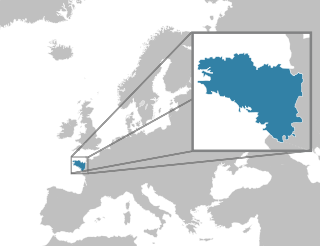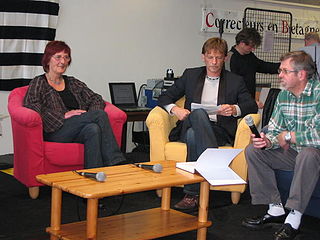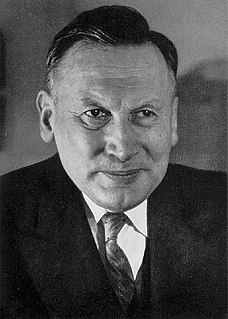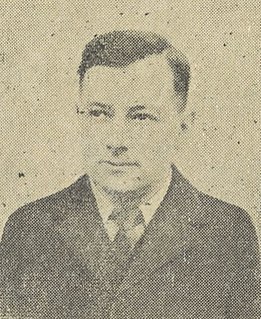Related Research Articles

Breton is a Southwestern Brittonic language of the Celtic language family spoken in Brittany, modern-day France.

Brittany is a peninsula and cultural region in the west of France, covering the western part of what was known as Armorica during the period of Roman occupation. It became an independent kingdom and then a duchy before being united with the Kingdom of France in 1532 as a province governed as a separate nation under the crown.

Rennes is a city in the east of Brittany in northwestern France at the confluence of the Ille and the Vilaine. Rennes is the capital of the region of Brittany, as well as the Ille-et-Vilaine department. In 2015, the city was the tenth largest in France, with a metropolitan area of about 720,000 inhabitants. The inhabitants of Rennes are called Rennais/Rennaises in French.

Breton literature may refer to literature in the Breton language (Brezhoneg) or the broader literary tradition of Brittany in the three other main languages of the area, namely, Latin, Gallo and French – all of which have had strong mutual linguistic and cultural influences.
Olier Mordrel is the Breton language version of Olivier Mordrelle, a Breton nationalist and wartime collaborator with the Third Reich who founded the separatist Breton National Party. Before the war, he worked as an architect. His architectural work was influenced by Art Deco and the International style of Le Corbusier. He was also an essayist, short story writer, and translator. Mordrel wrote some of his works under the pen names Jean de La Bénelais, J. La B, Er Gédour, A. Calvez, Otto Mohr, Brython, and Olivier Launay.

Before and during World War II, the various Breton nationalist movements were generally right-wing, and sometimes fascist. The extent to which this led to collaboration with the Nazi occupiers of France during the war, together with their motivations, is a matter of historical controversy.

Johann Leo Weisgerber was a Lorraine-born German linguist who also specialized in Celtic linguistics. He developed the "organicist" or "relativist" theory that different languages produce different experiences. He was the son of a village teacher who served as a young man in the German army in Flanders, so could not return to his home city. During World War II his pan-Celticist ideology was co-opted to support the German war effort, as did pro-Polish and pro-Czech ideology on the side of the allies.
Rennes is the capital city of the region of Brittany in northwestern France.

Roparz Hemon, officially named Louis-Paul Némo, was a Breton author and scholar of Breton expression. He was the author of numerous dictionaries, grammars, poems and short stories. He also founded Gwalarn, a literary journal in Breton where many young authors published their first writings during the 1920s and 1930s.
Job de Roincé, was a French journalist and writer, and also one of the founding figures of Breton nationalism.
René-Yves Creston, born René Pierre Joseph Creston, was a Breton artist, designer and ethnographer who founded the Breton nationalist art movement Seiz Breur. During World War II he was active in the French Resistance.
Xavier de Langlais was a Breton painter, printmaker and writer. He usually signed his work with the name Langleiz, a Breton language version of his surname.
Youenn Drezen is the Breton language name of Yves Le Drézen, a Breton nationalist writer and activist. He is also known as Corentin Cariou and Tin Gariou.
Gwalarn ("Northwesterly") was a Breton language literary journal. By extension, the term refers to the style of literature that it encouraged. 166 issues appeared between 1925 and May 1944.
Meavenn (1911–1992) was the pen name of Francine Rozec, also known as Fant Rozec, a Breton language poet, novelist and playwright linked to Breton nationalism.

François Eliès, born Fañch Eliès and better known by the pseudonym Abeozen, was a Breton nationalist, novelist and dramatist who wrote in the Breton language. Abeozen was also a noted scholar of the Welsh language.
Fañch Broudig or François Broudic is a Breton journalist and Breton- and French-language writer.

Ronan Huon, also called René Huon,, was a Breton language writer and editor. He was director and chief editor of the magazine Al Liamm for over fifty years. His work has been recognized for its contribution to the Breton language and its literature.
Al Liamm is a bimonthly magazine of culture and literature in the Breton language.
References
- ↑ La Radio en Langue bretonne. Roparz Hemon et Pierre-Jakez Hélias : deux rêves de la Bretagne, Ronan Calvez, Presses Universitaires de Rennes 2 (PUR), 2000, ISBN 2-86847-534-5 (thèse soutenue en décembre